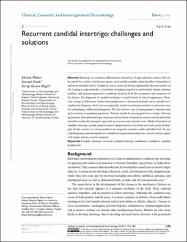| dc.contributor.author | Metin, Ahmet | |
| dc.contributor.author | Dilek, Nursel | |
| dc.contributor.author | Bilgili, Serap Güneş | |
| dc.date.accessioned | 2020-12-19T19:42:52Z | |
| dc.date.available | 2020-12-19T19:42:52Z | |
| dc.date.issued | 2018 | |
| dc.identifier.citation | Metin, A., Dilek, N., & Bilgili, S. G. (2018). Recurrent candidal intertrigo: challenges and solutions. Clinical, cosmetic and investigational dermatology, 11, 175–185. https://doi.org/10.2147/CCID.S127841 | en_US |
| dc.identifier.issn | 1178-7015 | |
| dc.identifier.uri | https://doi.org/10.2147/CCID.S127841 | |
| dc.identifier.uri | https://hdl.handle.net/11436/1967 | |
| dc.description | WOS: 000430340000001 | en_US |
| dc.description | PubMed: 29713190 | en_US |
| dc.description.abstract | Intertrigo is a common inflammatory dermatosis of opposing skin surfaces that can be caused by a variety of infectious agents, most notably candida, under the effect of mechanical and environmental factors. Symptoms such as pain and itching significantly decrease quality of life, leading to high morbidity. A multitude of predisposing factors, particularly obesity, diabetes mellitus, and immunosuppressive conditions facilitate both the occurrence and recurrence of the disease. the diagnosis of candidal intertrigo is usually based on clinical appearance. However, a range of laboratory studies from simple tests to advanced methods can be carried out to confirm the diagnosis. Such tests are especially useful in treatment-resistant or recurrent cases for establishing a differential diagnosis. the first and key step of management is identification and correction of predisposing factors. Patients should be encouraged to lose weight, followed up properly after endocrinologic treatment and intestinal colonization or peri-orificial infections should be medically managed, especially in recurrent and resistant cases. Medical treatment of candidal intertrigo usually requires topical administration of nystatin and azole group antifungals. in this context, it is also possible to use magistral remedies safely and effectively. in case of predisposing immunosuppressive conditions or generalized infections, novel systemic agents with higher potency may be required. | en_US |
| dc.language.iso | eng | en_US |
| dc.publisher | Dove Medical Press Ltd | en_US |
| dc.rights | info:eu-repo/semantics/openAccess | en_US |
| dc.subject | Candida | en_US |
| dc.subject | Intertrigo | en_US |
| dc.subject | Recurrent candidal intertrigo | en_US |
| dc.subject | Candidiasis | en_US |
| dc.subject | Candidosis | en_US |
| dc.subject | Candidal predisposals | en_US |
| dc.title | Recurrent candidal intertrigo: challenges and solutions | en_US |
| dc.type | review | en_US |
| dc.contributor.department | RTEÜ, Tıp Fakültesi, Dahili Tıp Bilimleri Bölümü | en_US |
| dc.contributor.institutionauthor | Dilek, Nursel | |
| dc.identifier.doi | 10.2147/CCID.S127841 | |
| dc.identifier.volume | 11 | en_US |
| dc.identifier.startpage | 175 | en_US |
| dc.identifier.endpage | 185 | en_US |
| dc.ri.edit | oa | en_US |
| dc.relation.journal | Clinical Cosmetic and Investigational Dermatology | en_US |
| dc.relation.publicationcategory | Diğer | en_US |


















